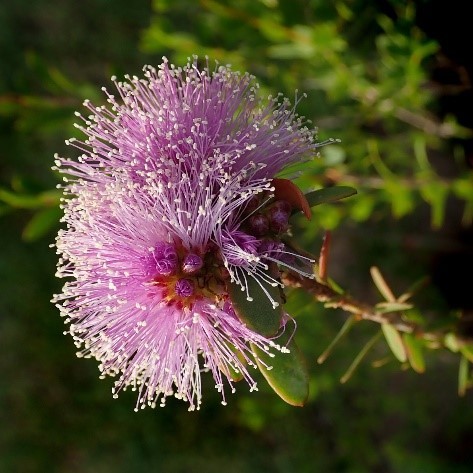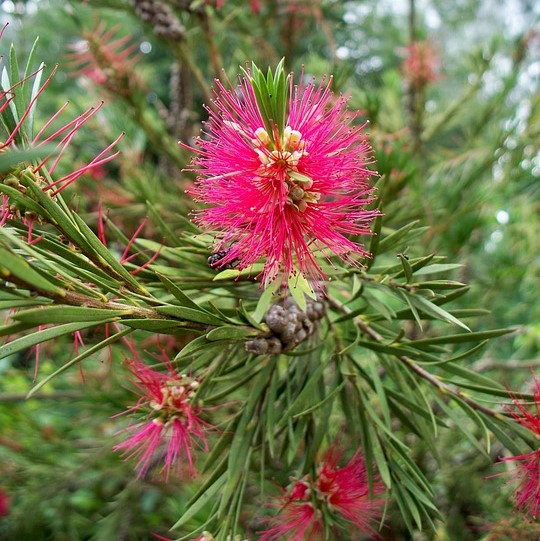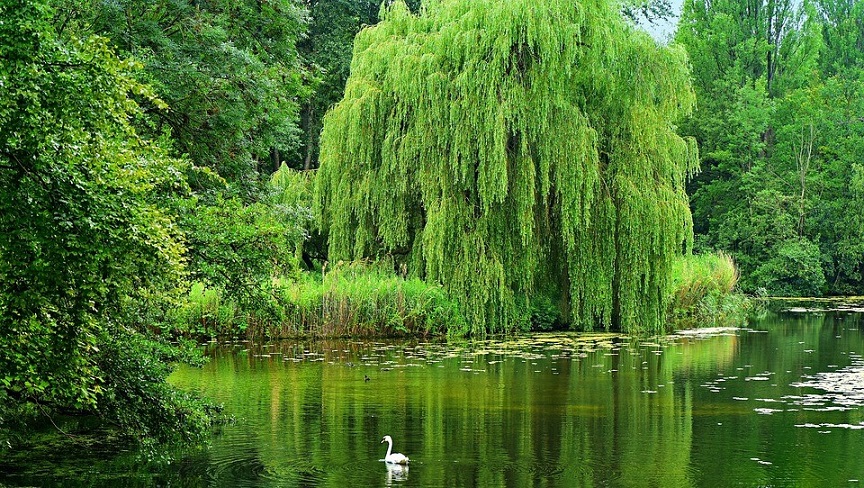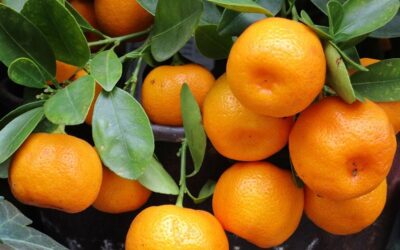It is remarkable to see how most people only look at pictures without reading the accompanying text. A few weeks ago, I posted an ad for Weeping Bottlebrush trees on my Facebook page and took the time to carefully write the name, description of the plant, and the price. You would be surprised to know how many people responded by asking about the ‘weeping willow’ and even inquired about its cost. I never realized how many actually refer to any weeping tree as a Weeping Willow. Today, I want to discuss the many differences between the Weeping Bottlebrush tree and the Weeping Willow tree, both of which are commonly found in gardens throughout Zambia.
A New Name for the Bottlebrush Family
The botanical name for the Weeping Bottlebrush is Melaleuca viminalis. Callistemon was previously the name for the bottlebrush tree species, while Melaleuca species are commonly known as paperbarks. The fact is that some bottlebrushes have papery bark, and most paperbarks have bottlebrush-like flowers. Because the differences between the two groups were insufficient to keep them separate, botanist Lyndley Craven decided to merge the genus Callistemon with its close relative Melaleuca in 2006. He transferred all the species previously known as Callistemon into Melaleuca because Melaleuca had been described before Callistemon.


Melaleuca alternifolia (Tea Tree) with its typically pale, flaking, papery bark
Melaleuca includes many species that feature a variety of bottlebrush-like flowers, which can be either cylindrical or globular in shape. These flowers are typically vibrant and dense, making Melaleuca a popular choice for gardeners looking to add both colour and texture to their landscapes. Additionally, the Melaleuca species are well-suited for tropical and subtropical climates, thriving in a range of soil types and environmental conditions.

Melaleuca nesophila
Pink Melaleuca, also known as Showy honey-myrtle

Melaleuca citrina
Lemon Bottlebrush Previously known as Callistemon citrinus

Melaleuca ‘Neon Pink’
Previously known as
Callistemon ‘Neon Pink’
All Melaleuca species provide excellent, long-lasting foliage that is highly valued in the cut flower industry, with some species also producing filler flowers. They can be cultivated for year-round foliage harvesting as well as for their flowering stems, which bloom in spring. In Zambia, the red bottlebrush varieties bloom several times throughout the year, adding vibrant color across multiple seasons.
Melaleuca viminalis (Weeping Bottlebrush)
The Weeping Bottlebrush is an evergreen, multi-trunked, large shrub that can also be pruned into a tree form, allowing it to grow much larger. It is a very showy plant with slender, arching, or drooping branches, especially during flowering when it bears abundant bright red bottlebrush flowers that attract bees, butterflies, and hummingbirds. In Zambia, the flowering season stretches almost year-round, with a short rest period in mid-winter.
Bottlebrush trees prefer full sun and tolerate heat very well. Plant them in well-draining soil, rich in organic matter. Once established, they can tolerate some drought, but regular watering will promote abundant flowering.


They respond well to heavy pruning, which can be done in mid-winter in Zambia. If you prune too late, you might not have any flowers in spring.
The leaves and twigs of the Melaleuca viminalis tree contain a high concentration of essential oils, which are believed to have antimicrobial, anti-inflammatory, and analgesic properties. As a result, the tree has been used to treat a variety of conditions, including skin infections, respiratory conditions, pain relief and oral health.
It is no wonder that it has been called ‘a dream of a tree’ and one of the most popular small flowering trees for tropical gardens.
Salix Babylonica (Weeping Willow Tree)
This graceful giant has long been prized for its delicate, arching branches, dramatic appearance, and rounded, weeping shape. Willows are deciduous, fast-growing trees characterized by their stout trunks and expansive canopies. These trees are known for their rapid growth, often reaching significant heights within just a few years. The robust trunks provide stability, while their extensive root
systems help prevent soil erosion. Willows are particularly valued in landscape design for their ability to create shade and their striking presence, making them a popular choice for both residential and public spaces



They grow well in full sun or partial shade and tolerate a variety of soils and climates. Young trees need regular watering. The weeping willow can be a spectacular specimen at the edge of a pond, with its branches gracefully weeping down to touch the water. Although they look their best when planted near water, they can also tolerate some drought once established.
During the summer, the leaves and stems of willows are a valuable source of fodder, especially during droughts. They are very palatable to livestock and have good digestibility. The nutritional value of willow is comparable to alfalfa, with a crude protein content of 15%, exceeding the dietary needs of livestock, mainly rabbits, goats, and sheep. The tannins in willow help balance lush grass growth after rain, preventing bloat in animals. Willow leaves are also rich in zinc and magnesium, essential minerals for animal health. Additionally, the tree bark is nutritious, and pollarded or coppiced branches can be fed to livestock.
Considering all these benefits, planting weeping willow trees on your property could be highly advantageous. Not only do these trees provide habitat and food for wildlife, including birds, insects, and aquatic creatures, but they also offer excellent shade and enhance the aesthetic appeal of your landscape with their graceful, weeping branches. Their rapid growth and adaptability to various soil types and climates make them a versatile addition to any garden.
How to Know them Apart
Weeping Bottlebrush Tree
Leaves are stiff, narrow and edges are smooth
Evergreen
Flowers are bright red spikes arranged to form the shape of a cylinder
Flowers grow only at the end of stems in spring and summer and early autumn
Trees are monoecious meaning both male and female flowers grow on the same tree
Bark is light brown, fibrous, brittle and flaky
.
Weeping Willow Tree
Leaves are soft, long and narrow with a finely serrated margin
Deciduous
Flowers are subtle and often go unnoticed, soft yellow, fuzzy catkins
Flowers grow on the leaf stems in early spring
Trees are dioecious, meaning male and female flowers grow on separate trees.
Bark is rough, grey-brown, cracked and can be deeply fissured in older trees
Conclusion
While the weeping bottlebrush tree and the weeping willow tree both feature graceful, cascading branches that add beauty to any landscape, they have distinct differences in appearance, growth habits, and care requirements. The weeping bottlebrush is known for its vibrant red flowers and evergreen foliage, making it a striking ornamental tree, whereas the weeping willow is admired for its elegant, drooping leaves and affinity for moist environments. You can now choose the tree that best suits your gardening needs.









